Multiband Signal Receiver by Using an Optical Bandpass Filter Integrated with a Photodetector on a Chip
Abstract
:1. Introduction
2. Architecture and Operation Principle of Multiband RF Signal Receiver
3. Photonic Integrated Chip Fabrication and Experimental Results
3.1. Silicon Photonic Integrated Chip
3.2. Multiband RF Signal Receiver
3.3. MWP Receiving System Performance
4. Discussion
5. Conclusions
Author Contributions
Funding
Institutional Review Board Statement
Informed Consent Statement
Data Availability Statement
Conflicts of Interest
References
- Capmany, J.; Novak, D. Microwave photonics combines two worlds. Nat. Photonics 2007, 1, 319–330. [Google Scholar] [CrossRef]
- Yao, J.P. Microwave photonics. J. Lightw. Technol. 2009, 27, 314–335. [Google Scholar] [CrossRef]
- Novak, D.; Waterhouse, R.B.; Nirmalathas, A.; Lim, C.; Gamage, P.A.; Clark, T.R., Jr.; Dennis, M.L.; Nanzer, J.A. Radio-over-fiber technologies for emerging wireless systems. IEEE J. Quantum Electron. 2016, 52, 1–11. [Google Scholar] [CrossRef]
- Duarte, V.C.; Prata, J.G.; Ribeiro, C.F.; Nogueira, R.N.; Winzer, G.; Zimmermann, L.; Walker, R.; Clements, S.; Filipowicz, M.; Napierała, M.; et al. Modular coherent photonic-aided payload receiver for communications satellites. Nat. Commun. 2019, 10, 1–9. [Google Scholar] [CrossRef] [Green Version]
- Ghelfi, P.; Laghezza, F.; Scotti, F.; Serafino, G.; Capria, A.; Pinna, S.; Onori, D.; Porzi, C.; Scaffardi, M.; Malacarne, A.; et al. A fully photonics-based coherent radar system. Nature 2014, 507, 341–345. [Google Scholar] [CrossRef]
- Ridgway, R.W.; Dohrman, C.L.; Conway, J.A. Microwave photonics programs at DARPA. J. Lightw. Technol. 2014, 32, 3428–3439. [Google Scholar] [CrossRef]
- Marpaung, D.; Roeloffzen, C.; Heideman, R.; Leinse, A.; Sales, S.; Capmany, J. Integrated microwave photonics. Laser Photon. Rev. 2013, 7, 506–538. [Google Scholar] [CrossRef] [Green Version]
- Marpaung, D.; Yao, J.P.; Capmany, J. Integrated microwave photonics. Nat. Photonics 2019, 80, 80–90. [Google Scholar] [CrossRef] [Green Version]
- Laghezza, F.; Scotti, F.; Ghelfi, P.; Bogoni, A. Photonics-assisted multiband RF transceiver for wireless communications. J. Lightw. Technol. 2014, 32, 2896–2904. [Google Scholar] [CrossRef]
- Borges, R.M.; Rodovalho, T.N.; Cerqueira Sodré Junior, A. Reconfigurable multi-band radio-frequency transceiver based on photonics technology for future optical wireless communications. IET Optoelectron. 2015, 9, 257–262. [Google Scholar] [CrossRef]
- Pan, S.L.; Zhu, D.; Liu, S.F.; Xu, K.; Dai, Y.T.; Wang, T.L.; Liu, J.G.; Zhu, N.H.; Xue, Y.; Liu, N.J. Satellite payloads pay off. IEEE Microw. Mag. 2015, 16, 61–73. [Google Scholar] [CrossRef]
- Rodio, L.; Schena, V.; Grande, M.; Calò, G.; D’Orazio, A. Photonic multi-frequency down conversion in hybrid microwave-photonic SATCOM payload. In Proceedings of the ELEKTRO Conference, Krakow, Poland, 23–26 May 2022. [Google Scholar]
- Scotti, F.; Laghezza, F.; Onori, D.; Bogoni, A. Field trial of a photonics-based dual-band fully coherent radar system in a maritime scenario. IET Radar Sonar Navig. 2017, 11, 420–425. [Google Scholar] [CrossRef]
- Pan, S.; Zhang, Y. Microwave photonic radars. J. Lightw. Technol. 2020, 38, 5450–5484. [Google Scholar] [CrossRef]
- Rahim, A.; Hermans, A.; Wohlfeil, B.; Petousi, D.; Kuyken, B.; Thourhout, D.V.; Baets, R. Taking silicon photonics modulators to a higher performance level: State-of-the-art and a review of new technologies. Adv. Photonics 2021, 3, 024003. [Google Scholar] [CrossRef]
- Shu, H.; Chang, L.; Tao, Y.; Shen, B.; Xie, W.; Jin, M.; Netherton, A.; Tao, Z.; Zhang, X.; Chen, R.; et al. Microcomb-driven silicon photonic systems. Nature 2022, 605, 457–463. [Google Scholar] [CrossRef]
- Chen, M.; Yu, H.; Yang, B.; Li, Y.; Chen, H.; Xie, S. A silicon integrated microwave-photonic transceiver. In Proceedings of the 2017 Optical Fiber Communications Conference and Exhibition, Los Angeles, CA, USA, 19–23 March 2017. [Google Scholar]
- Li, S.M.; Cui, Z.Z.; Ye, X.W.; Feng, J.; Yang, Y.; He, Z.Q.; Cong, R.; Zhu, D.; Zhang, F.Z.; Pan, S.L. Chip-based microwave-photonic radar for high-resolution imaging. Laser Photonics Rev. 2020, 14, 1900239. [Google Scholar] [CrossRef]
- Serafino, G.; Maresca, S.; Porzi, C.; Scotti, F.; Malacarne, A.; Amir, M.M.H.; Ghelfi, P.; Bogoni, A. Maritime field trial of a dual-band silicon integrated photonics-based radar. IEEE J. Sel. Topics Quantum Electron. 2022, 28, 8300610. [Google Scholar] [CrossRef]
- Zou, P.; Han, X.Y.; Wang, Y.; Wang, L.H.; Gu, Y.Y.; Wang, J.Y.; Jian, X.G.; Zhao, M.S. Study on a tunable ratio frequency filter based on integrated optical waveguide. Acta Optica Sinica 2013, 23, 1013001. [Google Scholar]
- Chi, H.; Zou, X.; Yao, J. Analytical models for phase-modulation based microwave photonic systems with phase modulation to intensity modulation conversion using a dispersive device. J. Lightw. Technol. 2009, 27, 511–521. [Google Scholar] [CrossRef]
- Rabus, D.G. Integrated Ring Resonators, 2nd ed.; Springer: Berlin/Heidelberg, Germany, 2007; pp. 327–347. [Google Scholar]
- Yariv, A. Critical coupling and its control in optical waveguide-ring resonator systems. IEEE Photonics Technol. Lett. 2022, 14, 483–485. [Google Scholar] [CrossRef] [Green Version]
- Han, X.Y.; Wang, L.H.; Wang, Y.; Zou, P.; Teng, J.; Gu, Y.Y.; Wang, J.Y.; Jian, X.G.; Morthier, G.; Zhao, M.S. UV-soft imprinted tunable polymer waveguide ring resonator for microwave photonic filtering. J. Lightw. Technol. 2014, 32, 3924–3932. [Google Scholar] [CrossRef]
- Feng, D.Z.; Liao, S.R.; Dong, P.; Feng, N.N.; Liang, H.; Zheng, D.W.; Kung, C.C.; Fong, J.; Shafiiha, R.; Cunningham, J.; et al. High-speed Ge photodetector monolithically integrated with large cross-section silicon-on-insulator waveguide. Appl. Phys. Lett. 2009, 95, 261105. [Google Scholar] [CrossRef]
- 3rd Generation Partnership Project. Technical Specification Group Radio Access Network; Terminal Conformance Specification; Radio Transmission and Reception (TDD) 3GPP TS 34.122 V11.13.0. October 2016. Available online: https://portal.3gpp.org/desktopmodules/Specifications/SpecificationDetails.aspx?specificationId=2365 (accessed on 9 October 2022).
- Urick, V.J.; Mckinney, J.D.; Williams, K.J. Fundamental of Microwave Photonics; John Wiley & Sons, Inc.: Hoboken, NJ, USA, 2015; p. 37. [Google Scholar]
- Liu, Y.; Marpaung, D.; Choudhary, A.; Hotten, J.; Eggleton, B.J. Link performance optimization of chip-based Si3N4 microwave photonic filters. J. Lightw. Technol. 2018, 36, 4361–4370. [Google Scholar] [CrossRef]
- Zhu, L.; Yang, W.; Connie, C. Very high efficiency optical coupler for silicon nanophotonic waveguide and single mode optical fiber. Opt. Express 2017, 25, 18462–18473. [Google Scholar] [CrossRef]
- Tzu, T.-C.; Sun, K.; Costanzo, R.; Ayoub, D.; Bowers, S.M.; Beling, A. Foundry-enabled high-power photodetectors for microwave photonics. IEEE J. Sel. Top. Quantum Electron. 2019, 25, 1–11. [Google Scholar] [CrossRef]
- Olinde, C.; Michelson, C.; Ward, C.; Stark, A. Integrated photonics for electromagnetic maneuver warfare. In Proceedings of the 2016 IEEE Avionics and Vehicle Fiber-Optics and Photonics Conference (AVFOP), Long Beach, CA, USA, 31 October –3 November 2016; pp. 181–182. [Google Scholar] [CrossRef]
- Lembo, L.; Maresca, S.; Serafino, G.; Scotti, F.; Amato, F.; Ghelfi, P.; Bogoni, A. In-field demonstration of a photonic coherent MIMO distributed radar network. In Proceedings of the 2019 IEEE Radar Conference, Boston, MA, USA, 22–26 April 2019. [Google Scholar]
- Calabretta, N.; Kraemer, R.; Wang, Y.; Napoli, A.; Nakamura, F.; Tsuda, H.; Prifti, K.; Srivathsa, B.; Delrosso, G.; Aalto, T.; et al. Photonic integrated WDM switches and filters for ultra-wideband (O to L) optical networks. In Proceedings of the 2021 IEEE Photonics Society Summer Topicals Meeting Series (SUM), Cabo San Lucas, Mexico, 19–21 July 2021. [Google Scholar]
- Orlandi, P.; Morichetti, F.; Strain, M.; Sorel, M.; Bassi, P.; Melloni, A. Photonic integrated filter with widely tunable bandwidth. J. Lightw. Technol. 2013, 32, 897–907. [Google Scholar] [CrossRef]
- Chen, G.; Yu, Y.; Shi, Y.; Li, N.; Luo, W.; Cao, L.; Danner, A.J.; Liu, A.-Q.; Zhang, X. High-speed photodetectors on silicon photonics platform for optical interconnect. Laser Photonics Rev. 2022, 16, 2200117. [Google Scholar] [CrossRef]
- Li, J.; Yang, S.; Chen, H.; Wang, X.; Chen, M.; Zou, W. Fully integrated hybrid microwave photonic receiver. Photonics Res. 2022, 10, 1472–1483. [Google Scholar] [CrossRef]
- Chen, G.; Li, N.; Ng, J.D.; Lin, H.L.; Zhou, Y.; Fu, Y.H.; Lee, L.Y.T.; Yu, Y.; Liu, A.Q.; Danner, A.J. Advances in lithium niobate photonics: Development status and perspectives. Adv. Photonics 2022, 4, 034003. [Google Scholar] [CrossRef]
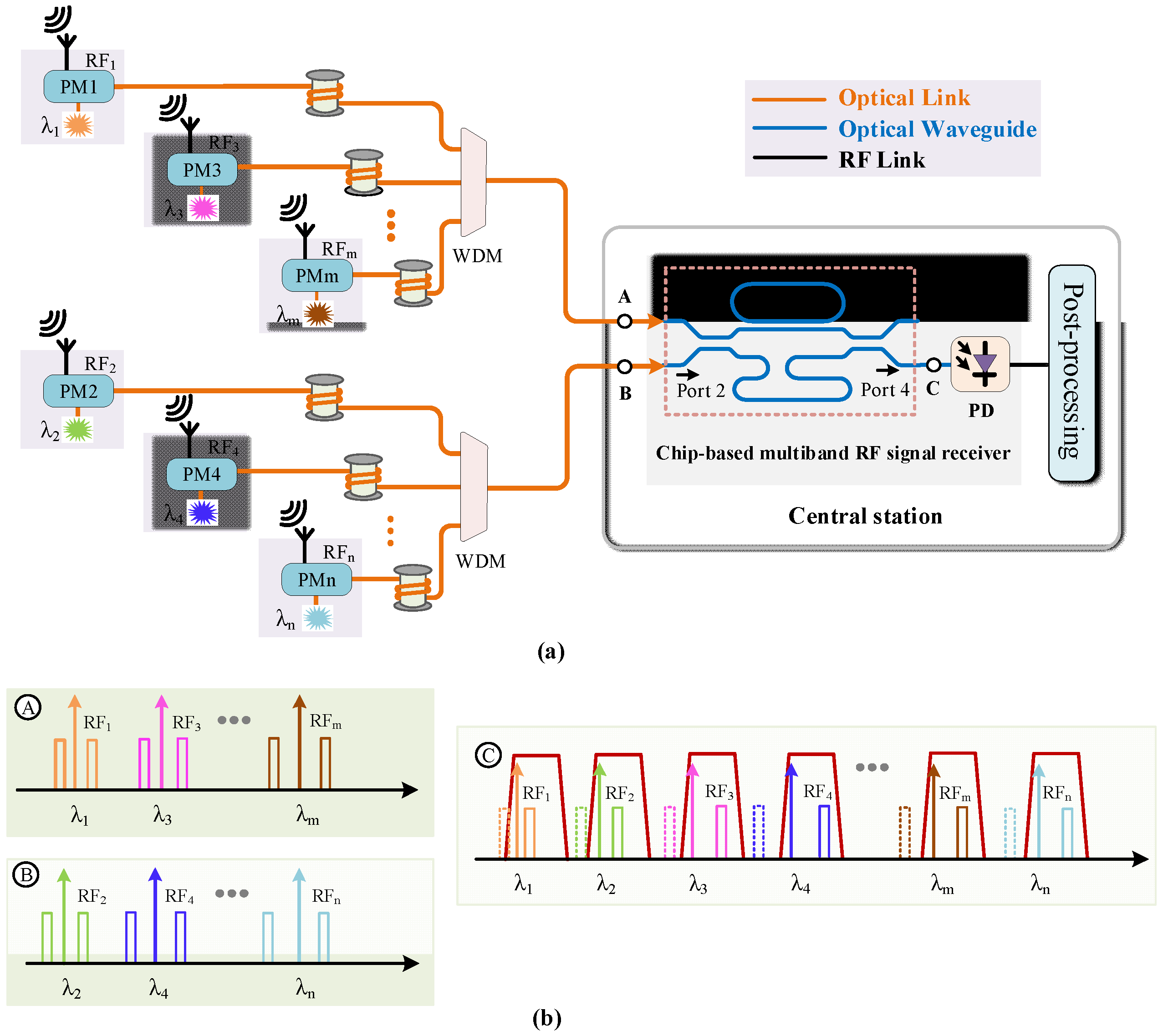
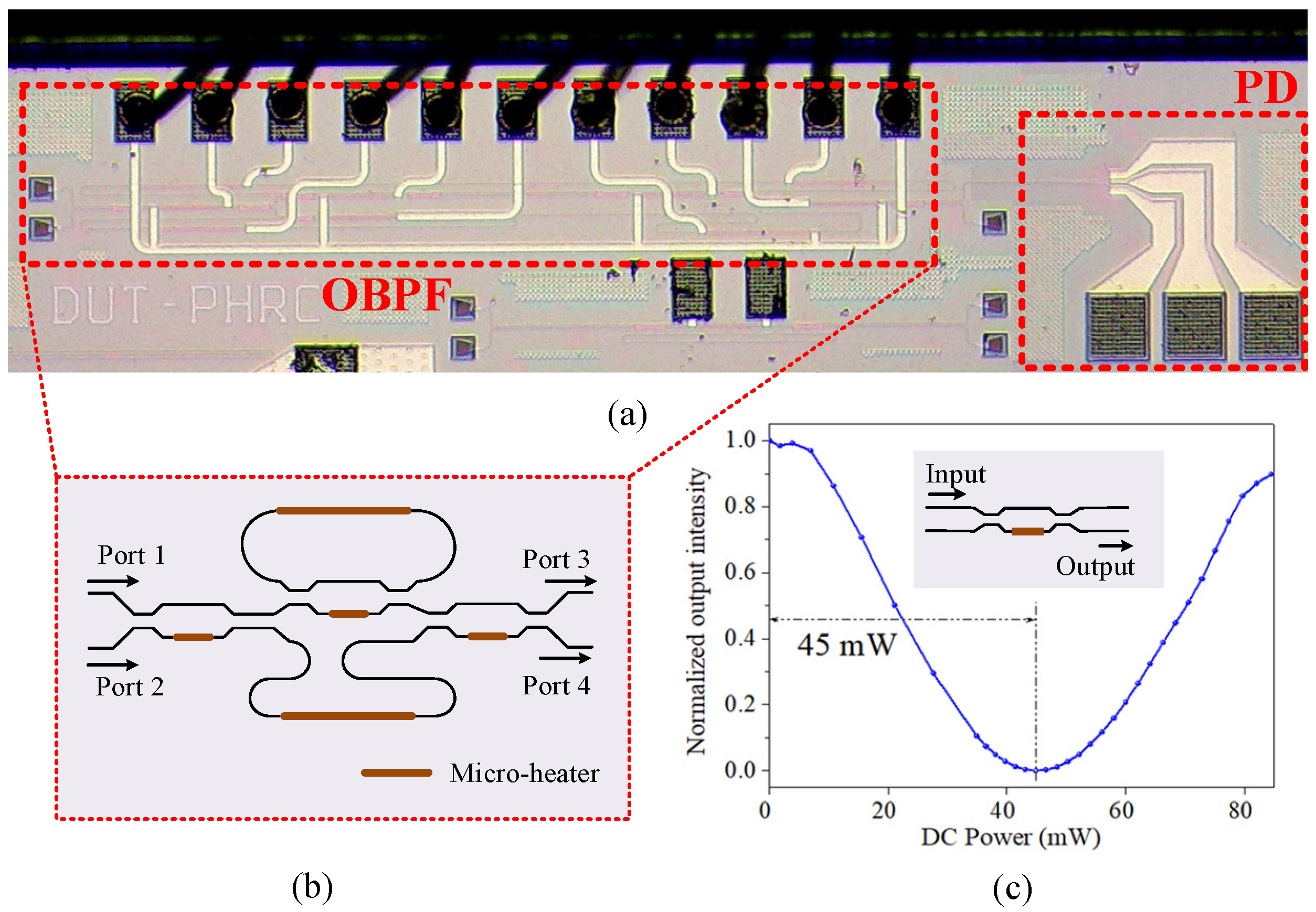
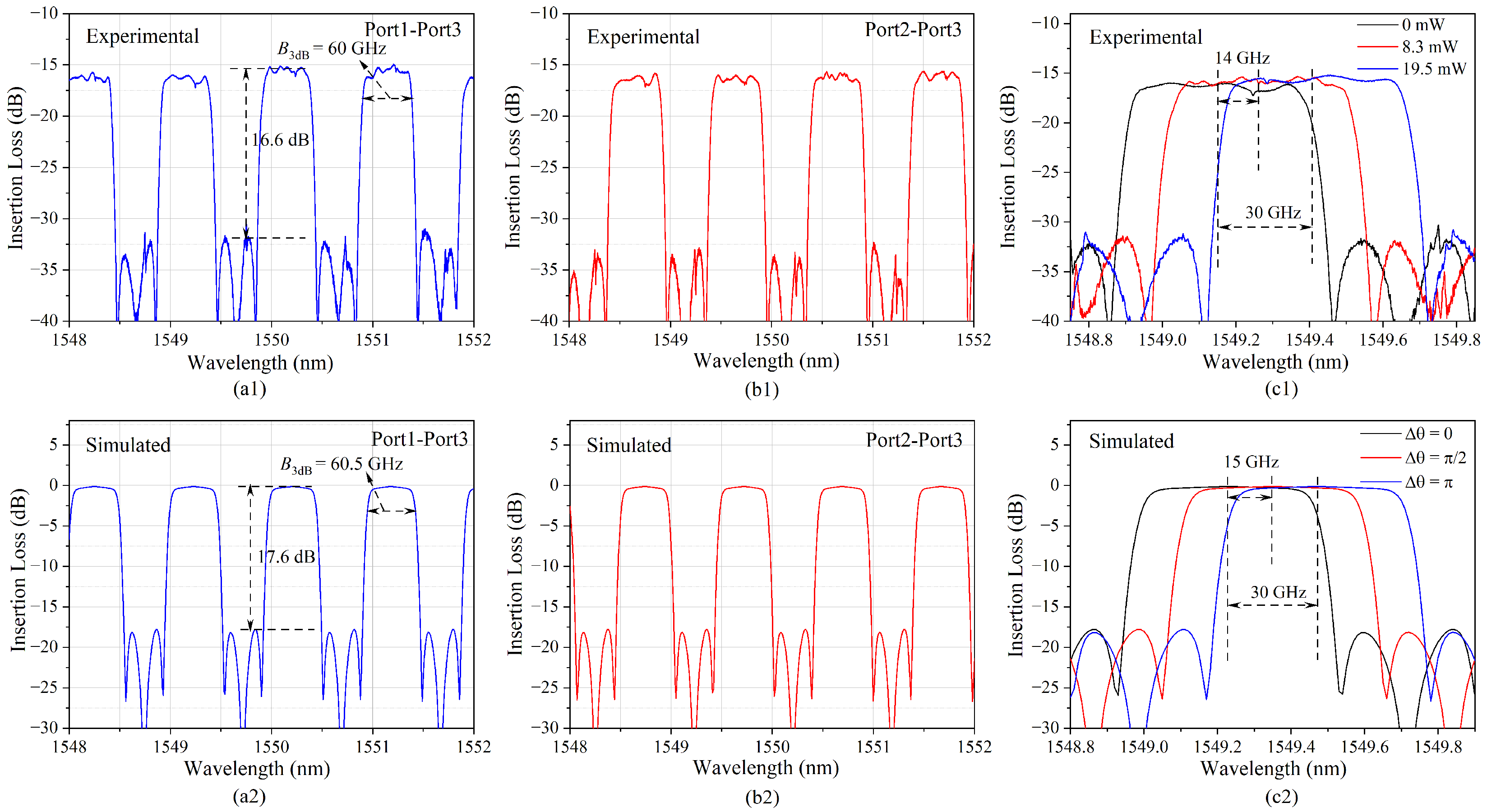


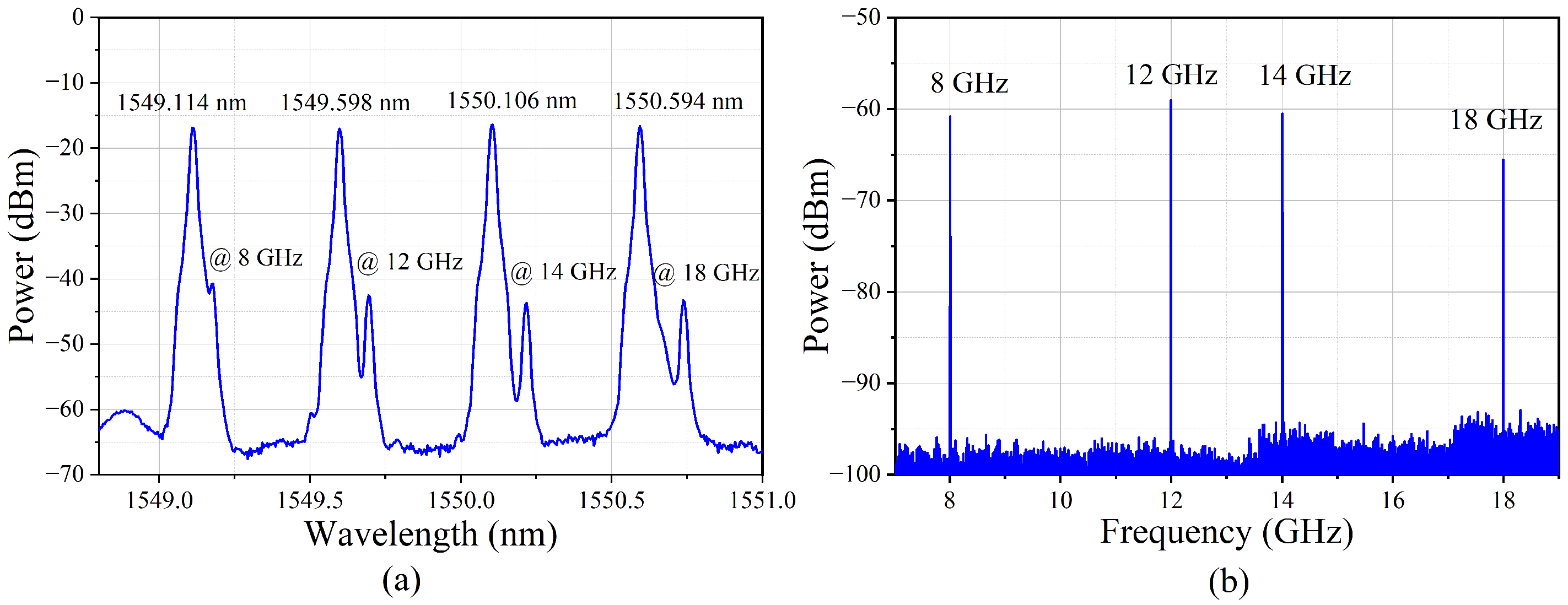
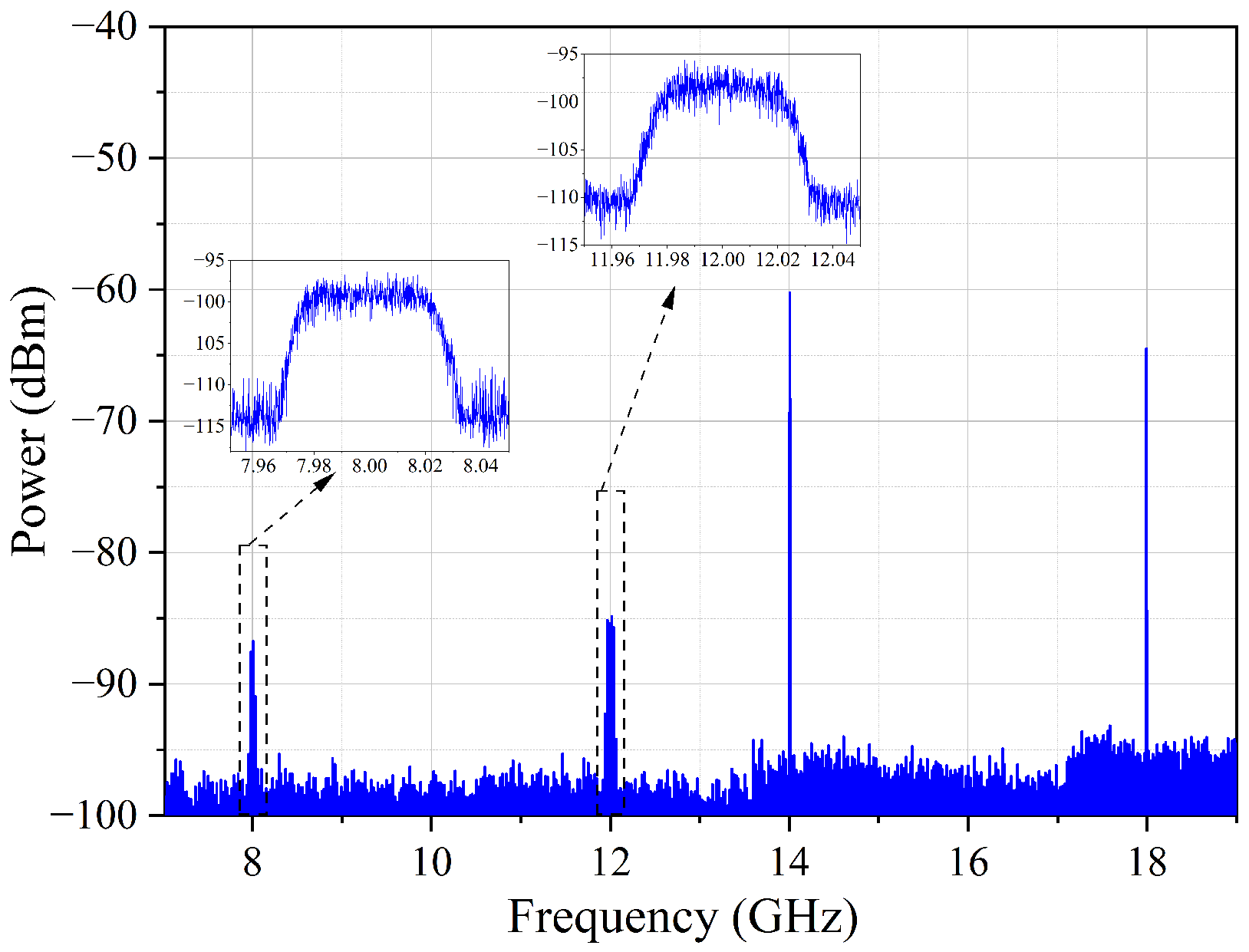
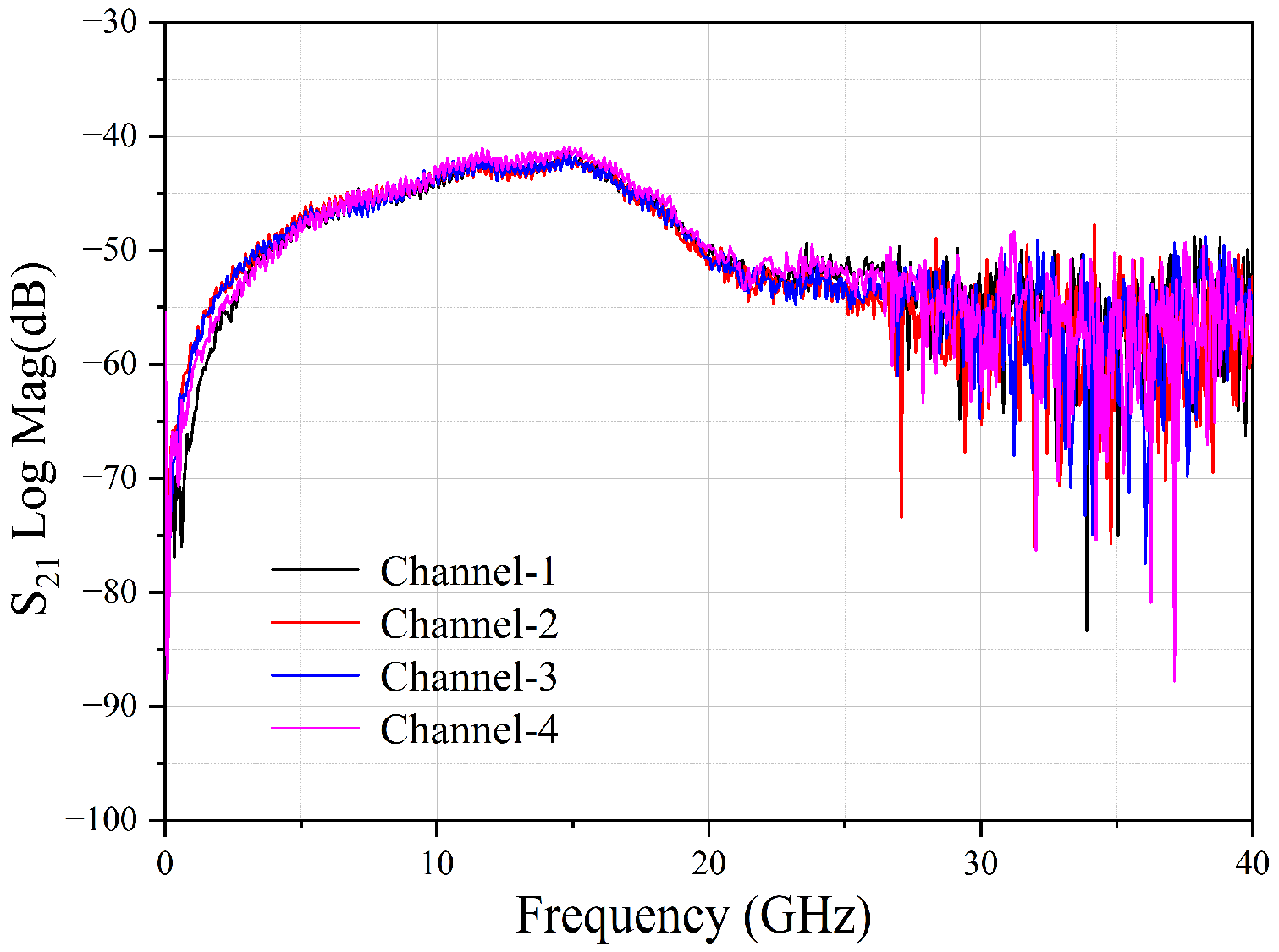
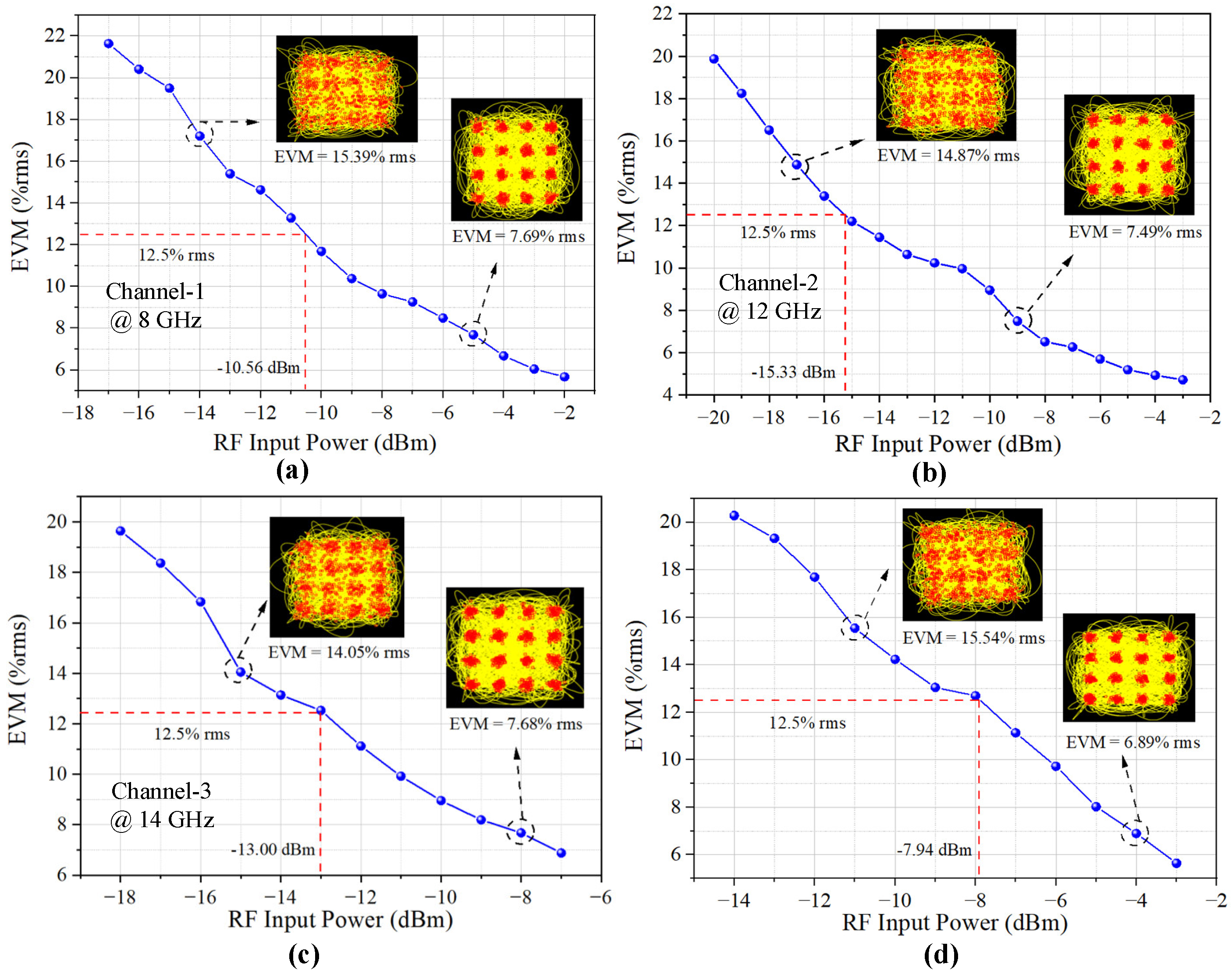

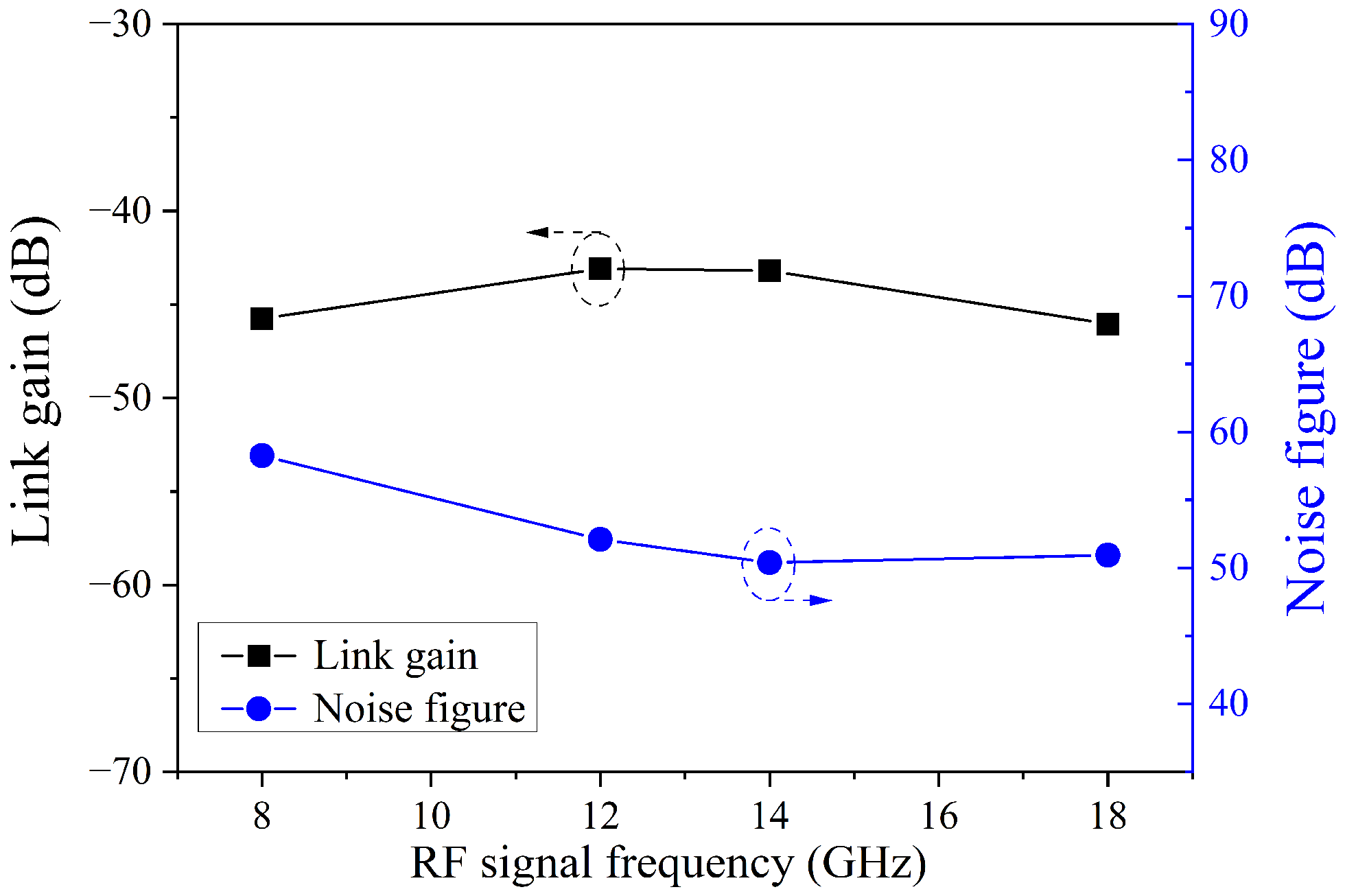
Disclaimer/Publisher’s Note: The statements, opinions and data contained in all publications are solely those of the individual author(s) and contributor(s) and not of MDPI and/or the editor(s). MDPI and/or the editor(s) disclaim responsibility for any injury to people or property resulting from any ideas, methods, instructions or products referred to in the content. |
© 2023 by the authors. Licensee MDPI, Basel, Switzerland. This article is an open access article distributed under the terms and conditions of the Creative Commons Attribution (CC BY) license (https://creativecommons.org/licenses/by/4.0/).
Share and Cite
Han, X.; Chao, M.; Su, X.; Wang, W.; Fu, S.; Wu, Z.; Zhao, M. Multiband Signal Receiver by Using an Optical Bandpass Filter Integrated with a Photodetector on a Chip. Micromachines 2023, 14, 331. https://doi.org/10.3390/mi14020331
Han X, Chao M, Su X, Wang W, Fu S, Wu Z, Zhao M. Multiband Signal Receiver by Using an Optical Bandpass Filter Integrated with a Photodetector on a Chip. Micromachines. 2023; 14(2):331. https://doi.org/10.3390/mi14020331
Chicago/Turabian StyleHan, Xiuyou, Meng Chao, Xinxin Su, Weiheng Wang, Shuanglin Fu, Zhenlin Wu, and Mingshan Zhao. 2023. "Multiband Signal Receiver by Using an Optical Bandpass Filter Integrated with a Photodetector on a Chip" Micromachines 14, no. 2: 331. https://doi.org/10.3390/mi14020331
APA StyleHan, X., Chao, M., Su, X., Wang, W., Fu, S., Wu, Z., & Zhao, M. (2023). Multiband Signal Receiver by Using an Optical Bandpass Filter Integrated with a Photodetector on a Chip. Micromachines, 14(2), 331. https://doi.org/10.3390/mi14020331





